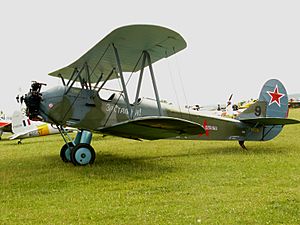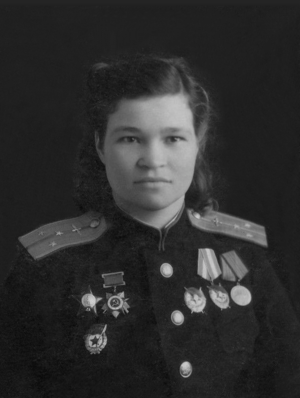Night Witches facts for kids
Quick facts for kids 588th Night Bomber Regiment (1942–1943)46th Guards Night Bomber Aviation Regiment (1943–1945) |
|
|---|---|

A Polikarpov Po-2, the aircraft type used by the regiment
|
|
| Active | 1942–1945 |
| Country | Soviet Union |
| Branch | Soviet Air Forces |
| Role | Harassment and tactical bombing |
| Nickname(s) | Night Witches |
| Engagements | Eastern Front of World War II |
| Decorations | Guards designation Order of the Red Banner Order of Suvorov |
| Commanders | |
| Regimental Commander | Yevdokiya Bershanskaya |
| Deputy Regiment Commander | Serafima Amosova |
| Commissar | Yevdokiya Rachkevich |
| Aircraft flown | |
| Bomber | Polikarpov Po-2 |
The "Night Witches" was a special group of all-female pilots in the Soviet Air Forces during World War II. The German soldiers gave them this nickname (German: die Nachthexen) because of their sneaky night attacks. Their official name was the 588th Night Bomber Regiment, later changed to the 46th "Taman" Guards Night Bomber Aviation Regiment.
At the time, women were usually not allowed to fight in combat. However, Major Marina Raskova used her influence with the Soviet leader Joseph Stalin to get permission. She wanted to form special combat units just for women. On October 8, 1941, an order was given to create three women's air force units, including the 588th Regiment.
This regiment was formed by Marina Raskova and led by Major Yevdokiya Bershanskaya. Most of the pilots were young women, many in their late teens and early twenties. They were volunteers who wanted to help their country.
The "Night Witches" had a unique way of attacking. They would fly their planes close to their target, then turn off their engines. They would then glide silently towards the bomb-release point. The only sound the German soldiers heard was the wind whistling. This sound reminded them of broomsticks, which is how the pilots got their spooky nickname. Because of the weight of the bombs and how low they flew, the pilots often did not carry parachutes until 1944.
In June 1942, the 588th Night Bomber Regiment joined the fight on the front line. In February 1943, the regiment was given a special honor called the Guards designation. It was then renamed the 46th Guards Night Bomber Aviation Regiment. Later, in October 1943, it became the 46th "Taman" Guards Night Bomber Aviation Regiment. The name "Taman" came from their important role in battles on the Taman Peninsula in 1943.
Contents
Forming the Regiment
In October 1941, Major Marina Raskova was given the job of choosing pilots for an all-female air group. Raskova was already famous for setting world records in long-distance flights. People even called her the "Russian Amelia Earhart."
When Germany invaded in 1941, many young women wrote to Raskova. They wanted to know how they could use their flying skills to help their country. Raskova used her personal connection with Stalin to get approval for the women's regiments. Stalin quickly agreed, partly because he saw the "Night Witches" as a great way to show the world what Soviet women could do.
Fighting and Flying Tactics
The regiment flew missions against the German military from 1942 until the end of World War II in 1945. They mostly flew missions to harass the enemy and drop bombs accurately. At its largest, the regiment had 40 crews, with two people in each plane.
The "Night Witches" flew over 23,000 missions during the war. They dropped more than 3,000 tons of bombs and 26,000 incendiary shells (bombs that cause fires). This made them the most decorated female unit in the Soviet Air Force. Many pilots flew over 800 missions. Twenty-three of them were given the highest honor, the Hero of the Soviet Union title. Sadly, 32 members of the regiment died during the war.
The planes they used were Polikarpov U-2 biplanes. These planes were made of wood and canvas. They were designed in 1928 for training pilots or for spraying crops. A special version, the U-2LNB, was made for night attacks. These planes could only carry about 350 kg (770 lb) of bombs. This meant the pilots often had to fly eight or more missions every night.
Even though the planes were old and slow, the pilots used their excellent maneuverability to their advantage. The Po-2 also flew slower than the lowest speed that German fighter planes like the Messerschmitt Bf 109 or Focke-Wulf Fw 190 could fly without stalling. This made it very hard for German pilots to shoot them down.
Important Battles and Operations
The members of the regiment arrived at the Southern Front on May 27, 1942. Their first combat missions were on June 12, 1942. They bombed river crossings and roads in southern Russia.
Here are some of the key operations they took part in:
- August–December 1942: They helped defend the city of Vladikavkaz during the Battle of the Caucasus. They also bombed enemy equipment and troops in several towns.
- January 1943: They helped break through enemy lines on the Terek River and supported attacks in the Kuban River valley.
- March – September 1943: They helped break through the Kuban bridgehead and free the city of Novorossiysk.
- April – July 1943: They participated in air battles over Kuban.
- November 1943 – May 1944: They supported ground troops in the Crimean Offensive and helped in the fight for Sevastopol.
- June–July 1944: They bombed enemy forts along the Pronya River. This helped take control of cities like Białystok, Cherven, Minsk, and Mogilev in Belarus.
- August 1944: They flew missions over Poland, helping to push the Germans out of cities like Augustów, Warsaw, and Ostrołęka.
- January 1945: They took part in the East Prussian Offensive.
- March 1945: They participated in attacks over Gdynia and Gdansk.
- April – May 1945: They helped in the Vistula–Oder Offensive.
The regiment was officially disbanded on October 15, 1945, after the war ended.
Missions and Achievements
Throughout the war, the "Night Witches" flew about 23,672 combat missions.
- Battle of the Caucasus – 2,920 missions
- Kuban, Taman, Novorossiysk – 4,623 missions
- Crimean Offensive – 6,140 missions
- Belarus Offensive – 400 missions
- Poland Offensive – 5,421 missions
- German Offensive – 2,000 missions
In total, the regiment flew for 28,676 hours. They dropped over 3,000 tons of bombs and more than 26,000 incendiary shells. They damaged or destroyed many enemy targets. These included 17 river crossings, nine railways, two railway stations, 26 warehouses, 12 fuel depots, 176 armored cars, 86 firing points, and 11 searchlights. Besides bombing, they also delivered supplies. They made 155 drops of food and ammunition to Soviet forces.
Who Were the Night Witches?
In total, 261 people served in the regiment. Sadly, 32 of them died during the war from various reasons. Twenty-eight aircraft were also lost.
Leaders of the Regiment
- Yevdokiya Bershanskaya – The main commander of the regiment.
- Serafima Amosova – The deputy commander.
- Yevdokiya Rachkevich – The political officer (commissar).
- Maria Fortus and later Irina Rakobolskaya – The chief of staff.
- Valentina Stupina and later Khiuaz Dospanova – The head of communications.
Honored Heroes
Many members of the regiment were recognized for their bravery.
- Twenty-three were awarded the title Hero of the Soviet Union.
- Two were awarded Hero of the Russian Federation.
- One was awarded Hero of Kazakhstan.
Heroes of the Soviet Union
- Raisa Aronova
- Vera Belik †
- Marina Chechneva
- Rufina Gasheva
- Polina Gelman
- Tatyana Makarova †
- Natalya Meklin
- Yevdokiya Nikulina
- Yevdokiya Nosal †
- Olga Sanfirova †
- Zoya Parfenova
- Yevdokia Pasko
- Nadezhda Popova
- Nina Raspopova
- Yevgeniya Rudneva †
- Yekaterina Ryabova
- Irina Sebrova
- Mariya Smirnova
- Maguba Syrtlanova
- Nina Ulyanenko
- Yevgeniya Zhigulenko
Heroes of the Russian Federation
- Aleksandra Akimova
- Tatyana Sumarokova
Hero of Kazakhstan
- Khiuaz Dospanova
Women in the Military After the War
In 1917, Russia was the first country to make women legally equal to men. This meant women could join the military. The idea was that women and men had equal rights and duties as citizens. However, in real life, things were not always equal, especially after World War II.
After the war, many women who had served faced pressure to focus on family life instead of military careers. Irina Rakobolskaya, a pilot with the 588th Regiment, spoke about this challenge. She felt that women fighting in the war was necessary for the country. But in peacetime, she believed women could only fly for fun. She wondered how a woman could have both a career and a family.
Other Women's Air Regiments
On October 8, 1941, an order was given to create three all-female air regiments. This meant that all the staff, from mechanics to pilots, would be women. The other two regiments were:
- The 586th Fighter Aviation Regiment: This group flew Yak-1 fighter planes.
- The 587th Bomber Aviation Regiment: This regiment used twin-engine Pe-2 dive bombers. It later became the 125th Guards Bomber Aviation Regiment.
While these regiments were planned to be all-female, some men did join them. For example, the 586th and 588th Regiments had male mechanics. This was because not enough women had been trained to work on certain planes before the war. Also, some commanders were later replaced by men. The 587th Regiment needed tall people to operate a machine gun, so some men joined as radio operators and tail gunners. The 588th Regiment also had male drivers and searchlight operators.
See also
 In Spanish: 588.º Regimiento de Bombardeo Nocturno para niños
In Spanish: 588.º Regimiento de Bombardeo Nocturno para niños


